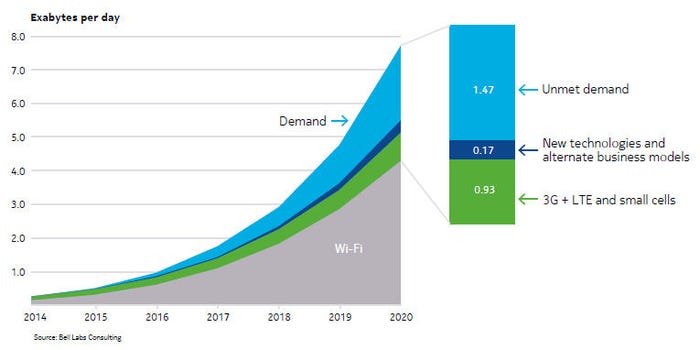Nokia Bell Labs research forecasts substantial 2020 mobile capacity shortfall
Bell Labs Consulting, now part of Nokia, has published a report forecasting overall demand for mobile connectivity by 2020.
April 14, 2016

Bell Labs Consulting, now part of Nokia, has published a report forecasting overall demand for mobile connectivity by 2020.
A key finding was that, at the current rate of development, only 81% of global demand will be met by wifi and cellular (of which two thirds will be wifi). In other words, according to infrastructure vendor Nokia, operators need to accelerate their infrastructure investment to overcome this projected shortfall.
Much of the report is occupied with detailing how mobile data consumption will evolve over the next four years. Bell Labs Consulting’s conservative estimate of global demand in 2020 is 8 exabytes (8 billion gigabytes) per day, but this could end up being as high as 12 exabytes. The current level is around 1 exabyte per day.
Regionally the major contributor to this growth will be ‘emerging Asia, Middle East and Africa’, which will see its share of global data consumption grow from 14% to 29%. Audio and video streaming will account for 79% of data consumption and while the anticipated explosion of IoT devices will have a relatively small impact on bandwidth (2% of total), the implications for the network – specifically control plane capacity – will be significant.
Marcus Weldon, president of Nokia Bell Labs and CTO, said: “The next evolution of humankind will involve ‘life automation’, and the creation of a world in which billions of interconnected things including smart objects, cameras, robots, sensors and processes exchange real time video and data streams – not only with people, but with cloud-based systems that extract knowledge from this data and perform tasks to make our work and home lives more convenient and our environments more intelligent,” said Marcus Weldon, president of Nokia Bell Labs and CTO.
“This new digital era will produce a dramatic shift in demand, challenging mobile operators to achieve the highest performance at the lowest cost per bit while supporting extensive personalization.”

About the Author
You May Also Like


.png?width=300&auto=webp&quality=80&disable=upscale)







.png?width=300&auto=webp&quality=80&disable=upscale)


_1.jpg?width=300&auto=webp&quality=80&disable=upscale)